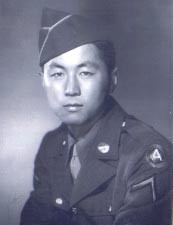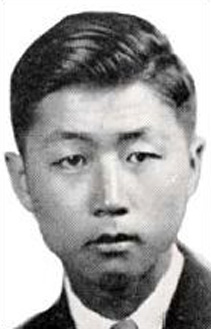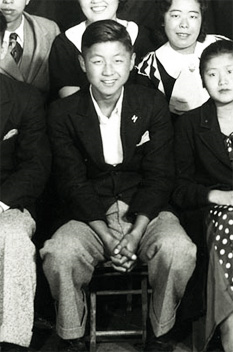
Fred Minoru Yamamoto
Private First Class
442nd Regimental Combat Team
3rd Battalion, K Company
Fred Minoru Yamamoto was born on October 19, 1918, in Glenwood, California, to Setaro and Yumi (Tanaka) Yamamoto. He was the middle child of three siblings – Tom Tomotsu, Fred, and Alice Mitsuye.
Setaro emigrated from the village of Mitsukochi, Kumamoto Prefecture, Japan, on the Korea Maru, arriving at San Francisco, California, on November 25, 1904. He worked as a woodman in the logging industry. He later returned to Japan and married Yumi Tanaka. On May 23, 1915, they sailed on the Nippon Maru from Nagasaki. The ship made a stop in Honolulu before arriving in San Francisco on June 15, 1915. At the time, Setaro was age 35 and a tenant farmer, and Yumi was pregnant and age 19. The ship manifest listed their last residence as Mitsukochi, Kumamoto Prefecture, and Setaro’s father as Sekichi Yamamoto.
Records do not show what happened to Setaro. By 1930, Yumi was married to Kihachi Sato, who had arrived from Japan in 1903, and was a widower with three children – Riyo, Kiyo, and Jack Kiju. They lived at 230 View Street in Mountain View with Umi’s three Yamamoto children. They owned and operated Sato Grocery, a retail grocery in Mountain View, Santa Clara County. In 1940, they were living at the same address with his son Jack Kiju Sato and the Yamamoto children.

Fred attended Mountain View Elementary and Junior High Schools. After he graduated from Palo Alto High School in 1936, he attended San Jose State Teachers College. He was a member of the Hinode basketball team, the YMCA, and the Page Mill Methodist Church youth league in Palo Alto.

Right: Fred’s senior class photo, 1936
On February 16, 1940, Fred registered for the draft at Local Board No. 112 in Palo Alto. His address was 230 View Street, Mountain View. His point of contact was his step-brother, Jack Sato of the same address. Fred was employed by Richard Woelffel in Cupertino, Santa Clara County. He was 5’8½” tall and weighed 135 pounds.
Left: Fred, member of Page Mill Church’s Epworth League
In August 1941, Fred moved to Dos Palos in California’s Central Valley to work on the Koda Rice Farm. On December 21, he met Michiko Yamada while attending Sunday School. They fell in love and by February she was the center of his life. He was intent on marrying her, and Michiko said she would wait for him.
In 1942, the Sato family, including the Yamamoto brothers, was evacuated to the Santa Anita WCCA Assembly Center, located at the Santa Anita Racetrack. On September 10, 1942, they were incarcerated at Heart Mountain WRA Relocation Center, an internment camp in northwest Wyoming. The family lived in Unit 24-18-C. Fred was a writer on the Heart Mountain Sentinel (newspaper) staff and an advisor to the Pegasus Club.
Fred was released on June 16, 1943, to Provo, Utah, for employment. His brother Tom, and Tom’s wife Nadine, were released on January 24, 1944, to Riverdale, New York, and August 26, 1943, to Cleveland, Ohio, respectively. Stepfather Kihachi Sato died at Heart Mountain on March 9, 1943, at the age of 56. Mother Umi was released on October 30, 1945, to Chicago, Illinois, and later moved back to Santa Clara County.
While at Heart Mountain, Fred was the first to volunteer for the Army. It was not a popular decision, especially with his mother, who feared he would be killed in the war. He enlisted in the U. S. Army on July 26, 1943, at Fort Francis E. Warren, Cheyenne, Wyoming. He was sent to Camp Shelby, Mississippi, and assigned to the 442nd Regimental Combat Team, 3rd Battalion, K Company.
After almost a year of basic and unit training, Fred shipped out to the Mediterranean Theater of Operations on May 2 in a large convoy of troop ships. They arrived at Naples, Italy, on May 28, and soon went by LST to the beachhead at Anzio. From Anzio, the 442nd transferred to a bivouac area near Civitavecchia, just north of Rome. The 442nd entered battle near Suvereto, north of Rome, on June 26. Fred fought in the Rome-Arno Campaign, up the western side of Italy, driving the German Army north of the Arno River.
Yamamoto was wounded in Italy, but recovered and was returned to duty. In the first week of September, the Regiment began withdrawing from the battlefront south to the Naples area. On September 27, they left Naples and landed in Marseilles, France, on September 30 for participation in the Rhineland-Vosges Campaign.
Their first objective was to liberate the important road junction of Bruyères in the Vosges Mountains. The intense battles to liberate Bruyères and neighboring Biffontaine lasted from October 16 to 24. The Combat Team was then put into reserve in Belmont for a rest. After only two days, on the afternoon of October 26, they were ordered to the front lines again to aid in the rescue of the “Lost Battalion” – the 1st Battalion of the 141st (Texas) Infantry Regiment. This battalion had gotten ahead of the lines and was surrounded on three sides by the enemy. Attempts by the 141st and other units to free it had been unsuccessful, so the 442nd was called in.
The next day, October 27, all three infantry battalions of the 442nd were in line abreast and launched an attack against the Germans. At 3:30 p.m. the Germans launched a counter-attack against I and K Companies. When their tanks were knocked out, the Germans slowly withdrew. As night fell, the 3rd Battalion did not pursue since it was impossible to maintain control in the pitch darkness. The next morning the Regiment resumed its assault on the German line.
Midway through the Lost Battalion rescue mission, Fred volunteered to be one of the 12 men needed to form a ration detail to retrieve supplies of food, water, and ammunition in anticipation of continued heavy fighting. Armed only with a rifle and an ammunition belt, with the anticipation of a heavy load on their return, the 12 men had gone out only 200 yards into the forest when they were attacked by a heavy artillery barrage.
Pfc. Fred Yamamoto was hit in his neck by shrapnel. He was one of the eight men of the 12-man ration detail who were killed in action on October 28, 1944.
Private First Class Fred Minoru Yamamoto was interred in the nearby U.S. Military Cemetery at Epinal, France, Plot C, Row 478. Eleven days after his death, his mother Yumi Sato received his Purple Heart Medal for his wounding during the Rome-Arno Campaign. On Sunday, November 19, 1944, memorial services were held for him in Detroit, Michigan, and Heart Mountain. His girlfriend, Michiko Yamada, attended the service at Heart Mountain.
On May 12, 1945, Pfc. Fred Minoru Yamamoto was posthumously awarded a Silver Star Medal for his bravery near Biffontaine in the Rhineland-Vosges Campaign, per General Order No. 52, Headquarters 5th Army. The Citation reads:
The President of the United States of America, authorized by Act of Congress July 9, 1919, takes pride in presenting the Silver Star (Posthumously) to Private First Class Fred Minoru Yamamoto (ASN: 37357450) for gallantry in action while serving with Company K, 3rd Battalion, 442nd Regimental Combat Team, 36th Infantry Division, in action against the enemy on 27 and 28 October 1944 near Biffontaine, France. When his platoon was counter-attacked by two German companies, Private First Class Yamamoto an automatic rifleman, single-handedly killed two Germans, wounded an undetermined number, and checked the attack until the platoon reached the safety of higher ground. The following day, he killed a machine pistol gunner and two supporting riflemen. For two days, until he was mortally wounded, Private First Class Yamamoto continually exposed himself to heavy fire to support his company with effective automatic fire. His courage and fighting spirit are in keeping with the highest traditions of the Army of the United States.
For his military service, Private First Class Fred Minoru Yamamoto was awarded the Silver Star Medal, Bronze Star Medal, Purple Heart Medal with one oak leaf cluster, Good Conduct Medal, American Campaign Medal, European-African-Middle Eastern Campaign Medal with two bronze stars, World War II Victory Medal, Distinguished Unit Badge, and Combat Infantryman Badge. Fred was awarded the Congressional Gold Medal on October 5, 2010, along with the other veterans of the 100th/442nd Regimental Combat Team. This is the highest Congressional Civilian Medal.
When the Army was closing the many, small wartime cemeteries in Europe in 1948, Fred’s family was given the choice to have his remains shipped home or remain at the large cemetery at Epinal. They chose to have Fred brought home.
On June 21, 1948, Private First Class Fred Minoru Yamamoto was reinterred in Golden Gate National Cemetery, Section C, Grave 478. He was eulogized by his friend John Kitasako in a tribute that was printed in the Heart Mountain Sentinel. It reads in part:
The war strikes painfully and shockingly close to home when we learn that one so beloved as Fred came to his end on the field of battle. By every standard, Fred was a man’s man. To know him was to love him and respect him.
In his tall, slender frame was all that men honor and admire – the sterling qualities that make a man stand out among men. Fred always had and always gave a little extra – that little extra which bore the unmistakable stamp of sincerity and devotion.
In his thoughts, he had a little more honesty and consistency than the rest. In his work, he gave a little more devotion and conscientiousness. In his deeds, he showed a little more thoughtfulness and sincerity. In all the things that count in life, Fred was always above average.
Fred loved life; he loved it as no other fellow did. He liked to do the things that every wholesome youth yearns to do, and his enjoyment and appreciation of the simple things of life were so real and wholehearted that it warmed your heart to its depth.
But we must remember that in dying he gave his life for those principles which stood foremost in his heart. Fred met his death in the same manner and spirit he lived his life – with steadfast courage and an unwavering devotion to duty.
Fred would not have us mourn. Rather, he would have us take strength from the things for which he stood and fought and gave his life. Our tribute to Fred, while tinged with sorrow and despair, throws a stirring challenge to all of us to live a better, bigger life, a life of devotion, honesty, and love – just like Fred’s.
Fred’s brother, Tom Tomotsu Yamamoto, served in the Military Intelligence Service. His sister, Mitsue H. Yamamoto, served in the Quartermaster Corps.
For more information about Fred Yamamoto, go to the following: Fred Yamamoto Story and Donate to a Scholarship in Fred’s Name, and More – Fred Yamamoto
Researched and written by the Sons & Daughters of the 442nd Regimental Combat Team in 2022.
